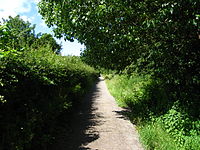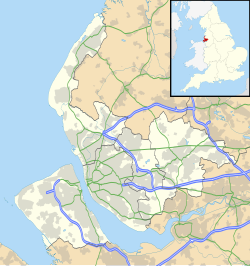The Wirral Country Park is a country park on the Wirral Peninsula, England, lying both in the Metropolitan Borough of Wirral in the county of Merseyside and in the borough of Cheshire West & Chester in the county of Cheshire. It was the first designated country park in Britain, opening in 1973.[1][2]
| Wirral Country Park | |
|---|---|
 The site of Kirby Park railway station, now given over to the Wirral Way. | |
Shown in Merseyside | |
| Type | Public park |
| Location | Station Road Thurstaston Merseyside CH61 0HN |
| Coordinates | 53°20′33″N 3°8′44″W / 53.34250°N 3.14556°W |
| Created | 1973 |
| Operated by | Metropolitan Borough of Wirral, Cheshire West & Chester |
| Open | All year |
| Status | Open |
The park is located along the Wirral Way, which follows the trackbed of part of the former Birkenhead Railway route from West Kirby[3] to Hooton.[4] The old line, which closed in 1962, follows the estuary of the River Dee for 7 miles (11 km) between West Kirby and Parkgate then heads inland, across the Wirral peninsula, to Hooton.
There are two visitor centres along the Wirral Way, one near the site of Thurstaston railway station, at Thurstaston, and the other at the preserved Hadlow Road railway station, in Willaston.
History
editWork began on the park in 1969, and the park was formally opened in 1973 by Lord Leverhulme. The park's creation followed a successful campaign by Captain Lawrence Beswick DSM, which prompted the necessary investment from the Countryside Commission.
Construction of the park required the removal of 30 miles (48 km) of railway track and accompanying sleepers, the digging and forming of drainage channels, levelling and consolidation of thousands of tons of gravel or ballast, and the removal of some brick-built road bridges. Some of the few remains of the original railway line are the old station platform at Thurstaston, the preserved 1950s-era railway station at Hadlow Road, Willaston, a number of bridges and occasional railway incline signs indicating the degree of climb or descent.
Wildlife
editThe park is home to badgers and foxes and to ten species of butterfly. The Dee estuary is home to populations of ragworm, lugworm, and cockles which support various species of bird in the area, including common redshanks, common shelducks, northern lapwings, skylarks, meadow pipits and common terns. During high spring tides visitors may also catch a glimpse of certain birds of prey such as peregrines, hen harriers and day-hunting short-eared owls.
Sports and recreation
editWirral Country Park is popular with ramblers and offers numerous walks, three being of particular note. First is the stretch of shoreline running a couple of miles from Thurstaston Beach to Heswall Beach, a popular route for horse riders as well. Second is The Wirral Way, a 13-mile (21 km) walk from West Kirby to Hooton. The country park itself lies along the Wirral Way towards the middle of this route.[5] Third is a 3.5-mile (5.6 km) circular Heswall Dales and fields walk,[6] via a small valley known as 'The Dungeon'.
The Wirral Coastal Walk is a well-known route within Merseyside, passing through Wirral Country Park and encompassing some of the aforementioned walks.[7] It is organised as an annual event by the Rotary Club, with over 5,000 taking part in 2008. The walk follows the Wirral coastline from Seacombe Ferry on the River Mersey to Thurstaston Country Park on the River Dee, a distance of 15 miles (24 km). The annual event has become a popular way for local charities and organisations to raise money for their cause.
Wirral Country Park is popular not only for its wildlife and country walking, but also cycling, horse riding, kite flying, quad biking and paragliding. The 12.2-mile (19.6 km) Wirral Way is popular with cyclists, especially at weekends. Part of the Wirral Endurance Ride, a horse-riding event in the Endurance GB National Championship, is held along the Wirral Way.[8]
Gallery
edit-
The pond at Thurstaston Visitor Centre
-
Inside Thurstaston Visitor Centre
-
The former Thurstaston railway station
-
Wirral Country Park at Station Road in Parkgate
See also
editReferences
edit- ^ "Wirral Country Park". Metropolitan Borough of Wirral. Retrieved 29 November 2018.
- ^ "About the park". Wirral Country Park Friends Group. Archived from the original on 3 December 2008. Retrieved 29 March 2008.
- ^ 53°22′24″N 3°06′32″W / 53.3732°N 3.109°W
- ^ 53°17′51″N 2°58′39″W / 53.2976°N 2.9774°W
- ^ The Wirral Way: Wirral, Visiting Thurstaston, retrieved 9 February 2009
- ^ "Heswall Fields and Dales Walk: Wirral". AllertonOak Mersey Walks. Archived from the original on 23 January 2010. Retrieved 13 July 2009.
- ^ "Wirral Coastal Walk: Wirral". The Rotary Club of North Wirral. Archived from the original on 9 May 2009. Retrieved 13 July 2009.
- ^ Ride Schedule Details: Wirral, Endurance GB, retrieved 9 February 2009
Further reading
edit- Merseyside Railway History Group (1982). The Hooton to West Kirby Branch Line. Metropolitan Borough of Wirral. ISBN 9780904582048. OCLC 60074290.
